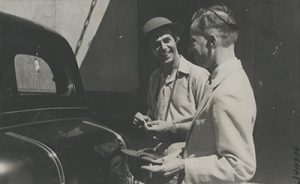Rudolph Brandt (1910-1982)
Rudolph Brandt was born on December 4, 1910 in a small Jewish village called Vereski, in the countryside outside of Prague. He was the oldest of five children. He was born Yosef Goldberger, into a prominent rabbinic family. His paternal grandfather, was a renown rabbi, a tzadik. People would come from all across Europe to consult with him, resolve legal disputes, and seek his blessing. His father, also a rabbi, served as a chaplain in the Austro-Hungarian army. His maternal grandfather was a prosperous merchant. He owned a general store which also served as the Royal Hungarian, and later, the Czech custom house. Yosef grew up speaking Hungarian, Czech, and Yiddish. He was fluent in all three languages. He also studied Hebrew as it was assumed that he would follow in the tradition of his family and become a rabbi. As a child, he studied the Hebrew Bible, the Talmud and the teachings of the rabbinic commentators.
Yosef also studied in the gymnasium, where he learned French and German. By 1929,he had left his family home and traveled across Europe, working as a tour guide and translator. Unable to receive a Czech passport without first serving in the Army and following an intention to shed his Jewish identity, in a small cafe near Metro Saint Paul in Paris, Yosef bought a German passport and an identity card. On that day, with the exchange of 300 francs, Rudolph Brandt was born. In 1931, Rudolph traveled from London to Tampico, Mexico. The boat, which carried him to Mexico was designed to carry freight and 30 passengers. It was packed with over 250 Jews from across Europe. The passage took 30 days.
In Mexico, Rudolph taught himself Spanish and became a salesman, traveling throughout the Mexican interior selling shoes, dresses, toothpaste and brushes. After a year, he settled in Mexico City and became a liquor merchant. Throughout his childhood, the United States had a great lure for Rudolph. He heard stories of the great opportunities in America. In late 1932, he illegally crossed into the United States from Laredo, Mexico. He traveled around the United States, living briefly in New York, Los Angeles, and Oklahoma City. Over the next years, an adventurous and restless Brandt, left the United States and traveled through Mexico, South America, and Europe. In 1937, Brandt found himself in Shanghai, where he witnessed the first Sino-Japanese incident. It was in Shanghai that Brandt established himself as a photo-journalist and was hired by United Press International (UPI) to produce a pictorial report of the Sino-Japanese War. There he befriended the Far East Manager of the UPI, John R. Morris, and worked for him for two years, covering the bombings in Shanghai and traveling north toward Peking to photograph the army of General Mao Tse-tung. Next Brandt traveled to Nanking to photograph what became known as “the rape of Nanking” and then returned to Shanghai via Canton. From Shanghai, he traveled to Singapore, where he photographed for “The Straight Times Annual”, and then to Manila, where he pursued advertising and commercial photography. In the early 1940’s, Brandt returned to the United States. He settled in Berkeley, California and landed a job as a photographer with the San Francisco Examiner, working for the manager of the city desk, Josh Eppinger.
With the outbreak of World War 2 on December 7, 1941, Brandt was arrested as a suspected spy and interred for a time at Terminal Island and McNeil Island, where he was detained with Japanese Americans. In 1943, cleared of all charges, Brandt volunteered to serve in the United States Armed Forces. He was assigned to the Army Air Corp and was dispatched to the Pacific theater of operations, where he photographed Japanese naval activities. Brandt completed his military service in 1946 and landed a position in the training section of the United States Veteran’s Administration. Through this work, he became interested in psychology and enrolled in the University of Southern California where he received a Master’s in Psychology. Brandt received a Doctor in Psychology from the University of Ottawa and subsequently studied under Oscar Phister in Switzerland and became a Psychoanalyst. He returned to Los Angeles where he established a successful private practice. Throughout the 1960s and 70s, Brandt was active in psychoanalytic circles. A fellow in numerous professional societies, he directed the Melrose School for Emotionally Disturbed Children, stared in a weekly television show, Dr. Brandt’s Cable Couch, served as a member of the State of California Board of Medical Examiners and as visiting Professor at the University of California. Brandt volunteered for numerous civic organizations.
Though his professional career as a photographer ended with the close of World War 2, he continued to take photographs throughout his life, and maintained a color darkroom in his home in Los Angeles.
Rudolph Brandt was married to Suzanne Brandt, and had two children. He died on January 27, 1982 at the age of 72 . Rudolph is survived by his two children and four grandchildren, including his namesake, granddaughter Rudy Brandt.
See our publication “1937 Japan Attacks China!”






 +49 89 29 73 42
+49 89 29 73 42